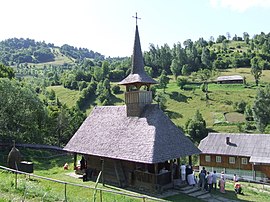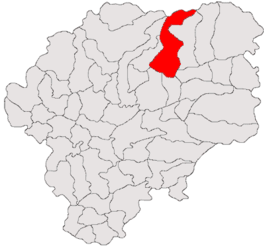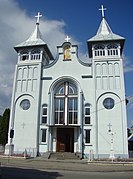Sângeorz-Băi
This article needs additional citations for verification. (February 2020) |
Sângeorz-Băi | |
|---|---|
 Wooden church in Sângeorz-Băi | |
 Location in Bistrița-Năsăud County | |
| Coordinates: 47°22′12″N 24°40′48″E / 47.37000°N 24.68000°E | |
| Country | Romania |
| County | Bistrița-Năsăud |
| Government | |
| • Mayor (2020–2024) | Traian Ogâgău[1] (Ind.) |
| Area | 146.82 km2 (56.69 sq mi) |
| Elevation | 446 m (1,463 ft) |
| Population (2021-12-01)[2] | 10,931 |
| • Density | 74/km2 (190/sq mi) |
| Time zone | EET/EEST (UTC+2/+3) |
| Postal code | 425300 |
| Area code | (+40) 02 63 |
| Vehicle reg. | BN |
| Website | www |
Sângeorz-Băi (also spelled Sîngeorz-Băi, Romanian pronunciation: [sɨnˈd͡ʒe̯orz bəj]; Hungarian: Oláhszentgyörgy; German: Sankt Georgen) is a spa resort and town in the mountain region of Bistrița-Năsăud County in Transylvania, Romania. The town administers two villages, Cormaia (Kormája) and Valea Borcutului (Borpatak).
Geography
[edit]The town is situated on the northeastern edge of the Transylvanian Plateau, at the foot of the Rodna Mountains, partly within the Rodna Mountains National Park. It lies on the banks of the river Someșul Mare; the river Cormaia discharges into the Someșul Mare a short distance upstream.
Sângeorz-Băi is located in the northern part of the county, on the border with Maramureș County. It lies at a distance of 30 km (19 mi) from Năsăud, and 40 km (25 mi) from the county seat, Bistrița. The town is traversed by national road DN17 (part of European route E58), which joins Dej in Cluj County to Suceava.
Demographics
[edit]| Year | Pop. | ±% |
|---|---|---|
| 1966 | 6,693 | — |
| 1977 | 8,243 | +23.2% |
| 1992 | 10,280 | +24.7% |
| 2002 | 10,702 | +4.1% |
| 2011 | 9,679 | −9.6% |
| 2021 | 10,931 | +12.9% |
| Source: Census data | ||
At the 2021 census, Sângeorz-Băi had a population of 10,931.[3] At the 2002 census, 97.8% of inhabitants were Romanians, 1.5% Roma and 0.5% Hungarians; 73.1% were Romanian Orthodox, 19.7% Pentecostal, and 5.9% Greek-Catholic.
Education
[edit]The town is the home of the Solomon Haliță Theoretical High School.[4]
Natives
[edit]- Gabi Balint (b. 1963), footballer
References
[edit]- ^ "Results of the 2020 local elections". Central Electoral Bureau. Retrieved 6 June 2021.
- ^ "Populaţia rezidentă după grupa de vârstă, pe județe și municipii, orașe, comune, la 1 decembrie 2021" (XLS). National Institute of Statistics.
- ^ "Populația rezidentă după grupa de vârstă, pe județe și municipii, orașe, comune, la 1 decembrie 2021" (in Romanian). INSSE. 31 May 2023.
- ^ "Liceul Teoretic "Solomon Haliță"". www.solomonhalita.ro (in Romanian). Retrieved November 24, 2021.






